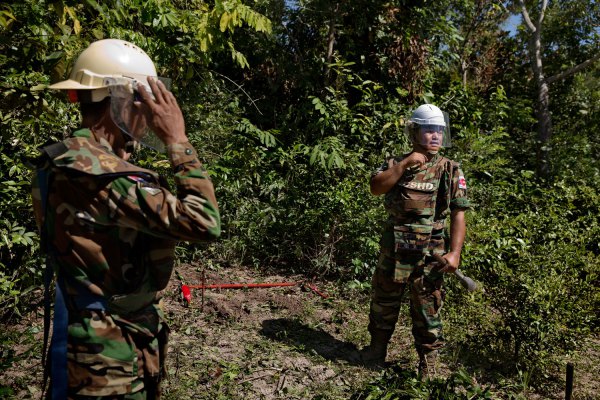
They stand to attention in neat rows, soldiers battling an invisible yet deadly enemy. At the fore, clad in military fatigues, is Aki Ra, all eyes on his cherubic face as he issues the day’s instructions. Upon dismissal, the team dons Kevlar vests and begins the laborious process of chopping back vegetation and delicately prodding wherever the telltale, high-pitched whine of the metal detector betrays something beneath the dank soil. Often it’s a piece of shrapnel — a remnant of decades of savage conflict. But sometimes, a hockey-puck-size antipersonnel land mine is discovered and destroyed with a controlled explosion.
Cambodia was once blighted by up to 6 million land mines — indiscriminate weapons that brook no distinction between marauding combatant and inquisitive child. Made largely in the USSR and China, they were used by Cambodia’s once warring factions, including the notorious Khmer Rouge, to impede their enemies.
Aki Ra has dedicated his life to curing this subterranean plague. About 20 years ago, armed with just rudimentary tools — a pocket knife, pliers, a stick — he set about single-handedly removing land mines and unexploded ordnance from his homeland’s verdant quilt of paddy fields and lush jungle. Aki Ra says from 1992 to 2007 he personally cleared about 50,000 mines. The human cost of this scourge becomes apparent to any visitor to Cambodia — the pockmarked nation has an estimated 40,000 amputees. Today, Aki Ra’s NGO, Cambodian Self Help Demining (CSHD), funded by foreign governments and private donations, works with a team of around 30, mainly in the country’s north, where the majority of mines remain. “I want to make my country safe for my people,” says Aki Ra.
His life and cause reflect the suffering Cambodia has undergone. Aki Ra thinks he was born in 1970, but cannot be sure, as his parents were among the more than 1 million Cambodians slaughtered in the Khmer Rouge’s killing fields. He was conscripted into the Khmer Rouge at age 10 — first to cook, hunt and wash clothes for the soldiers, but was soon handed a gun. “We believed what they told us, as we didn’t have any choice,” he says. “I didn’t know anything of the outside world.” It was during this fraught time that Aki Ra first became familiar with land mines. “Sometimes I would carry around 100 with me in a sack,” he says. “Every week I would see someone hurt by them.”
When the Khmer Rouge attempted to reclaim long-disputed territory by the Vietnamese border, they found their battle-hardened neighbors — fresh from besting first the Chinese and then American militaries — unwilling to acquiesce. The Vietnamese invaded and took control of Phnom Penh in 1979. Aki Ra was captured six years later. Facing execution, he started fighting for his captors against his former Khmer Rouge allies. “Once I saw my uncle in the enemy line opposite me, so I shot over his head to avoid killing him,” he says with a grin.
The Vietnamese withdrew in 1989, and Aki Ra faced his third conscription, this time into the Cambodian army, to battle the lingering fragments of the routed Khmer Rouge. Only then, aged around 20, did he finally receive any semblance of a school education — Aki Ra now speaks English, Japanese, Thai, Vietnamese, French and some Russian, along with his native Khmer.
U.N. peacekeepers rolled into Cambodia in 1992 to help facilitate a democratic transition, and Aki Ra was recruited to help clear land mines — work that came naturally to him. “When we were shooting during the war, we would always be feeling for mines with our feet,” he says, shuffling the dirt by way of demonstration. (Land mines generally take around 10 kg of force to detonate, so are unlikely to explode with gentle probing.)
By 1997, Aki Ra had collected so many bomb casings, weapons and unexploded ordnance that he opened the Cambodia Landmine Museum in Siem Reap. An adjacent school and relief center for orphans, young land-mine victims and rural destitute followed. More than 100 children have since passed through the organization — 27 are currently at school and nine are studying at university. Aki Ra also has three children of his own — one called, intriguingly, Mine. “As a baby he would sleep with a lot of land-mine casings around,” explains Aki Ra, “and whenever he woke up he would play with them. The name just stuck.”
Because of the vast collective effort of NGOs and government agencies, land-mine casualties in Cambodia have plummeted from about 4,300 in 1996 to 77 in the first half of this year. Since 2008, Aki Ra’s CSHD team has put some 100,000 people back on 180 cleared hectares of land. In a nation where an estimated quarter of the 14 million population subsists on less than $1 a day, that’s an enormous achievement.
Just an hour’s drive east of historic Angkor Wat, Van Pok, 33, farms bananas, potatoes, rice and coconuts next to Aki Ra’s latest clearance project. “I was very scared of the bombs because of my two young children,” she says. Soon the village will build a house and a vegetable garden on the onetime minefield — a dream now possible on a land that no longer kills.
More Must-Reads from TIME
- L.A. Fires Show Reality of 1.5°C of Warming
- Home Losses From L.A. Fires Hasten ‘An Uninsurable Future’
- The Women Refusing to Participate in Trump’s Economy
- Bad Bunny On Heartbreak and New Album
- How to Dress Warmly for Cold Weather
- We’re Lucky to Have Been Alive in the Age of David Lynch
- The Motivational Trick That Makes You Exercise Harder
- Column: No One Won The War in Gaza
Write to Charlie Campbell at charlie.campbell@time.com